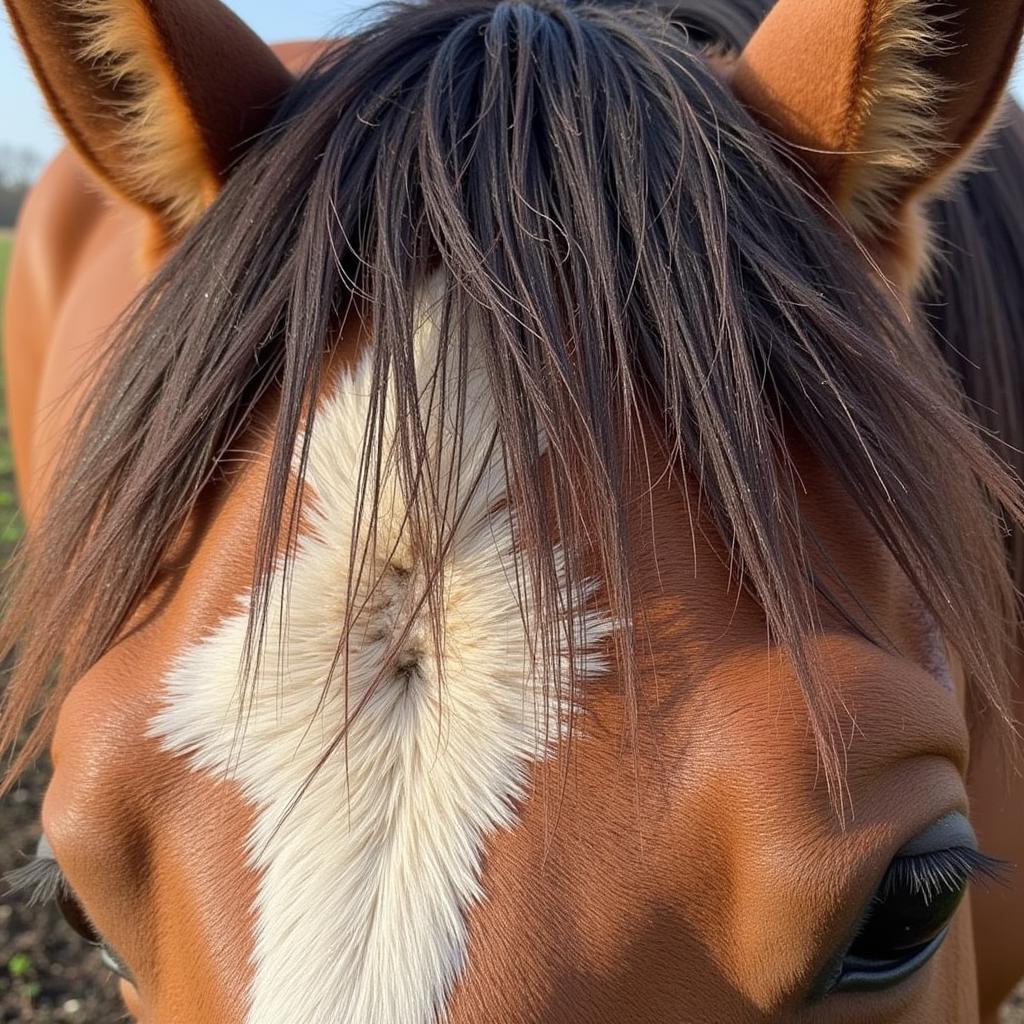Sweet itch in horses, also known as summer eczema, is a frustrating and often debilitating allergic reaction to the bites of Culicoides midges. These tiny insects, barely visible to the naked eye, can cause intense itching and discomfort, leading to hair loss, skin damage, and secondary infections. If you’re searching for “Sweet Itch Pictures On Horses,” you’re likely dealing with this challenging condition or trying to learn more about it. This article will provide a comprehensive overview of sweet itch, including its causes, symptoms, diagnosis, treatment, and prevention.
Understanding Sweet Itch in Horses
Sweet itch is a hypersensitivity reaction to the saliva of Culicoides midges. When these midges bite a susceptible horse, their saliva triggers an allergic response, causing intense itching. This leads to the characteristic symptoms of sweet itch: rubbing, scratching, and biting at the affected areas. The mane and tail are often the first areas affected, hence the name “sweet itch,” as horses rub these areas on objects to relieve the itch.
Recognizing the Signs: Sweet Itch Pictures and Symptoms
Horses with sweet itch typically exhibit a range of symptoms, varying in severity from mild itching to severe skin lesions. Recognizing these signs early is crucial for effective management.
- Intense itching: This is the hallmark symptom of sweet itch. Affected horses will constantly rub, scratch, and bite at the itchy areas.
- Hair loss: Constant rubbing leads to hair loss, especially along the mane, tail, and midline of the back.
- Skin lesions: The skin can become inflamed, thickened, and scabby. Secondary bacterial infections can further complicate the condition.
- Restlessness and irritability: The constant itching can make horses restless, irritable, and difficult to handle.
 Sweet Itch Horse Mane Damage: Close-up of a horse's mane showing hair loss, scabbing, and inflammation due to sweet itch.
Sweet Itch Horse Mane Damage: Close-up of a horse's mane showing hair loss, scabbing, and inflammation due to sweet itch.
Diagnosing Sweet Itch
Diagnosing sweet itch is typically based on the characteristic clinical signs and a history of seasonal recurrence. While skin scrapings can be performed to rule out other skin conditions like mites or fungal infections, the primary diagnostic tool is recognizing the pattern of itching and observing the typical distribution of lesions.
Managing Sweet Itch: Treatment and Prevention Strategies
While there’s no cure for sweet itch, several management strategies can help alleviate the symptoms and improve the horse’s quality of life.
- Midge control: Reducing exposure to midges is key. This involves stabling horses during peak midge activity (dawn and dusk), using fly sheets and masks, and applying insect repellents.
- Medications: Corticosteroids can help reduce inflammation and itching, while antihistamines may provide some relief. Always consult with a veterinarian before administering any medications.
- Topical treatments: Soothing creams and ointments can help alleviate itching and promote healing.
- Environmental management: Eliminate standing water and manure piles, which are breeding grounds for midges.
Long-Term Management of Sweet Itch
Living with sweet itch can be a long-term commitment. Consistent management practices are crucial for controlling the symptoms and preventing further complications.
- Regular grooming: Regular grooming helps remove allergens and debris, reducing irritation.
- Dietary management: Some horses benefit from dietary changes, such as adding omega-3 fatty acids to their diet.
- Stress reduction: Stress can exacerbate sweet itch symptoms. Providing a calm and predictable environment can help manage the condition.
 Sweet Itch Horse Fly Sheet: A horse wearing a fly sheet designed to protect it from midge bites, a key preventative measure against sweet itch.
Sweet Itch Horse Fly Sheet: A horse wearing a fly sheet designed to protect it from midge bites, a key preventative measure against sweet itch.
Conclusion: Minimizing the Impact of Sweet Itch
Sweet itch is a chronic condition that requires ongoing management. By understanding the causes, recognizing the symptoms, and implementing effective treatment and prevention strategies, horse owners can significantly reduce the impact of this frustrating condition and improve their horses’ well-being. Remember, early intervention is crucial. If you suspect your horse has sweet itch, consult with your veterinarian for a proper diagnosis and treatment plan.
FAQ:
- What is the best treatment for sweet itch in horses? There is no cure, but managing midge exposure and using appropriate medications and topical treatments can effectively control symptoms.
- Is sweet itch contagious? No, sweet itch is not contagious. It is an allergic reaction, not an infectious disease.
- Can sweet itch be prevented? While it can’t be entirely prevented, minimizing midge exposure and implementing appropriate management strategies can significantly reduce the severity of symptoms.
- What are the first signs of sweet itch in horses? Intense itching, particularly in the mane and tail region, is usually the first noticeable sign.
- What time of year is sweet itch worst? Sweet itch is typically worse during the warmer months when midges are most active.
- Can sweet itch be cured completely? No, sweet itch is a chronic condition, but effective management can significantly control the symptoms.
- What does sweet itch look like on a horse? Sweet itch manifests as hair loss, skin lesions, and inflammation, primarily in the mane, tail, and midline of the back.
Need further assistance? Contact us at Phone Number: 0772127271, Email: [email protected] Or visit us at QGM2+WX2, Vị Trung, Vị Thuỷ, Hậu Giang, Việt Nam. We have a 24/7 customer service team.